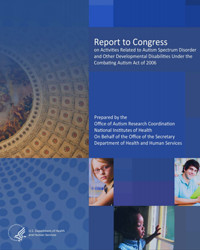Report to Congress
on Activities Related to Autism Spectrum Disorder and Other Developmental Disabilities
FY 2006 - FY 2009
Public Law 109-416 (PDF – 49 KB), the Combating Autism Act of 2006 was signed into law on December 19, 2006. The CAA authorizes expanded activities related to autism spectrum disorder (ASD) research, surveillance, prevention, treatment, and education. Provisions of the CAA encourage the integration of health, education, and community services as well as ensure that citizens have a voice in ASD-related government activities. Specifically, the CAA:
- Expands, subject to availability of appropriations, and consolidates NIH research activities in ASD
- Authorizes a review of NIH-funded centers of excellence for autism research and epidemiology
- Establishes ASD surveillance and awareness programs under the CDC
- Increases Federal efforts in autism education, early detection, and intervention
- Establishes the Interagency Autism Coordinating Committee to coordinate all ASD-related efforts within HHS and provide advice to the Secretary of Health and Human Services on matters pertaining to ASD
- Authorizes appropriations for Federal ASD-related efforts
- Requires a Report to Congress on progress in implementing the provisions of the CAA
Section 399DD states, "Not later than 4 years after the Combating Autism Act of 2006, the Secretary in coordination with the Secretary of Education, shall prepare and submit to the Health, Education, Labor, and Pensions Committee of the Senate and the Energy and Commerce Committee of the House of Representatives a progress report on the activities related to autism spectrum disorder and other developmental disabilities."
As stated in the CAA, the report submitted shall contain—
- "A description of the progress made in implementing the provisions of the Combating Autism Act of 2006"
- "A description of the amounts expended on the implementation of the particular provisions of Combating Autism Act of 2006"
- "Information on the incidence of autism spectrum disorder and trend data of such incidence since the date of enactment of the Combating Autism Act of 2006"
- "Information on the average age of diagnosis for children with autism spectrum disorder and other disabilities, including how that age may have changed over the 4-year period beginning on the date of enactment of this Act"
- "Information on the average age for intervention for individuals diagnosed with autism spectrum disorder and other developmental disabilities, including how that age may have changed over the 4-year period beginning on the date of enactment of this Act"
- "Information on the average time between initial screening and then diagnosis or rule out for individuals with autism spectrum disorder or other developmental disabilities, as well as information on the average time between diagnosis and evidence-based intervention for individuals with autism spectrum disorder or other developmental disabilities"
- "Information on the effectiveness and outcomes of interventions for individuals diagnosed with autism spectrum disorder, including by various subtypes, and other developmental disabilities and how the age of the child may affect such effectiveness"
- "Information on the effectiveness and outcomes of innovative and newly developed intervention strategies for individuals with autism spectrum disorder or other developmental disabilities"
- "Information on services and supports provided to individuals with autism spectrum disorder and other developmental disabilities who have reached the age of majority (as defined for purposes of section 615(m) of the Individuals with Disabilities Education Act (20 U.S.C. 1415(m))"
Two Federal departments and many Federal agencies and offices that address ASD research or services have contributed information provided in this Report to Congress, including: Administration for Children and Families (ACF), Agency for Healthcare Research and Quality (AHRQ), Centers for Disease Control and Prevention (CDC), Centers for Medicare & Medicaid Services (CMS), Department of Education (ED), HHS Office on Disability (OD), Health Resources and Services Administration (HRSA), Substance Abuse and Mental Health Services Administration (SAMHSA), five Institutes of the National Institutes of Health (NIH), and the NIH Director. Information sharing and Federal coordination on ASD-related activities has been greatly facilitated by the Interagency Autism Coordinating Committee (IACC).
This report begins with a summary of the IACC's role in the strategic coordination of Federal ASD efforts and the reciprocal communication of ASD relevant issues to the public. The subsequent chapters address each of the 9 sections required in the report by the CAA.




